The highest speed in the world by car and any ground managed vehicle - 1227,986 km / h - was shown on a Thrust SSC jet car by the Englishman Andy Green on October 15, 1997. A 21 km long track was marked on the bottom of a dried lake in the Black Rock desert, Nevada, USA. Green’s car was driven by two Rolls-Royce Spey turbofan engines with accelerated thrust with a total capacity of 110,000 liters. from.
Encyclopedic YouTube
1 / 1
TOP 10 All The Fastest in the World!
Subtitles
Bluebird Electric Speed \u200b\u200bRecords
Sir Malcolm Campbell nine times broke the world speed record for various Bluebird cars - Bluebird. On the sandy coast of Wales Pendine Sands, he set the following records:
- On September 25, 1924, Campbell set a record at 146.16 mph on a Sunbim car.
- July 21, 1925 he reached a speed of 242.79 km / h, breaking the milestone of 150 mph.
Subsequently, Campbell abandoned the Sanbim cars and built his own car.
- In early 1927, Campbell on Pendina Beach (UK) raised a speed record to 281 km / h.
A year later, Campbell went to the start with a new “Blue Bird”. There, in Dayton, he set a record of 333 km / h.
- In 1935, on Lake Bonneville, Utah, he reached a speed of 301.12 mph or 484.620 km / h.
Campbell set his last record on the famous dried salt lake Bonneville in Utah, finding that the salt surface of the lake is not only perfectly flat, but also provides excellent grip on tires. Almost all subsequent speed records were set on Bonneville. After that, Campbell, already middle-aged (he was 49 years old) left the sport, however, in 1940, breaking the world record for speed on water. Campbell's record was 237 km / h.
- His son, Donald, continued the tradition and overcame the 400 mph barrier while driving a Bluebird.
For the first time, Donald Campbell came out on a new Bluebird CN7 car to start in 1960 on Bonneville. And one of the races almost ended in disaster: the car soared at full speed, rolled over and hit the ground. Contrary to expectations, the rider escaped with light scratches. Having completely rebuilt the Blue Bird and attached a high keel to it for better exchange rate stability, Donald took it to Australia, to the salt lake Air, deciding that the Bonneville track is no longer suitable for such speeds. As a result, Donald managed to break the record only in 1964. It was 403 mph (648 km / h). When designing the machine, Donald Campbell counted on much more. But he must have been glad of this, especially since then he was officially considered the fastest racer of the planet.
- The holder of one of the world speed records now is Don Wales, the son of Donald Campbell and the grandson of Sir Malcolm Campbell. He set two American national records and eight records in the UK. Wales, following Donald Campbell, continued to set records, the first of which was the speed record for a car in 1998.
- In 2009, Don Wales set the current speed record for a 238.68 km / h (148.31 mph) steam car.
In total, 27 speed records were set on Bluebird cars.
Also
- The highest speed in the world on a motorcycle - 605.697 km / h - achieved on September 25, 2010 by American Rocky Robinson on the Bonneville Salt Lake.
- The highest speeds in the world on a bicycle - 334.6, 222.2 and 133.8 km / h - achieved on October 15, 1995, April 21, 2000, and September 14, 2013, respectively. a race for a leader - a car (which took on the bulk of aerodynamic drag and created a rarefied zone for a cyclist detaching from the leader at a speed of 160 km / h), with free descent and on a flat surface without a leader.
Incredible facts
15. The fastest person
Usain St. Leo Bolt, born August 21, 1986, is a Jamaican runner. Bolt holds the Olympic and world record for the fastest race for 100 meters (9.69 seconds), 200 meters (19.30 seconds) and 4x100 meters (37.10 seconds). Bolt was the first person (since 1984, when Carl Lewis did it) to win in three categories at one Olympics, and the first in the world to set world records in three categories. His name and achievements in the sprint led him to quickly be called the “Lightning Bolt” in the media.
14. The fastest production car
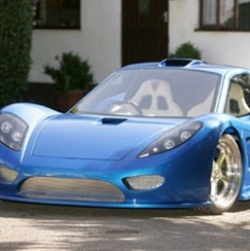 Bugatti Veyron is no longer the most fast car in the world. After numerous modifications, Barabus officially introduced the TKR: a new supercar with 1,005 horsepower, and, as the auto maker says, the car can accelerate to 98 km / h in 1.67 seconds. Moreover, its top speed is 270 mph, which is 20 more than the Veyron. All its power in a 6-liter V8 twin turbo engine with dual intercooler.
Bugatti Veyron is no longer the most fast car in the world. After numerous modifications, Barabus officially introduced the TKR: a new supercar with 1,005 horsepower, and, as the auto maker says, the car can accelerate to 98 km / h in 1.67 seconds. Moreover, its top speed is 270 mph, which is 20 more than the Veyron. All its power in a 6-liter V8 twin turbo engine with dual intercooler.
13. The fastest land animal
 The fastest land animal in the world is the miracle of the evolution of the cheetahs. Able to reach speeds of up to 70 mph, this slender long-legged feline is simply made for speed. Its spotty coat, small head and ears make the cheetah one of Africa's most recognizable large cats.
The fastest land animal in the world is the miracle of the evolution of the cheetahs. Able to reach speeds of up to 70 mph, this slender long-legged feline is simply made for speed. Its spotty coat, small head and ears make the cheetah one of Africa's most recognizable large cats.
12. The fastest computer
 K computer - Japanese supercomputer created by Fujitsu is a unique supercomputer. Currently the fastest computer in the world. It was activated in 2011, after installation at the Institute of Physical and Chemical Research in the Japanese city of Kobe. A supercomputer is operating with a maximum performance of 8.162 petaflops (8.162 quadrillion operations per second!). This is the only supercomputer of its kind, containing a large number of innovative ideas in its design.
K computer - Japanese supercomputer created by Fujitsu is a unique supercomputer. Currently the fastest computer in the world. It was activated in 2011, after installation at the Institute of Physical and Chemical Research in the Japanese city of Kobe. A supercomputer is operating with a maximum performance of 8.162 petaflops (8.162 quadrillion operations per second!). This is the only supercomputer of its kind, containing a large number of innovative ideas in its design.
 Sailboat is the only species in the genus of sailboats that lives in the warm waters of all the oceans of the world. As a rule, the color of the fish varies from blue to gray, it has a characteristic dorsal fin, which is stretched along the entire back. Another feature of this fish is an elongated bow, resembling a swordfish. The fish swims at a speed of 110 km / h, today it is the highest speed that fish can develop. If this fish could move on land, it would easily overtake a driver traveling along the highway.
Sailboat is the only species in the genus of sailboats that lives in the warm waters of all the oceans of the world. As a rule, the color of the fish varies from blue to gray, it has a characteristic dorsal fin, which is stretched along the entire back. Another feature of this fish is an elongated bow, resembling a swordfish. The fish swims at a speed of 110 km / h, today it is the highest speed that fish can develop. If this fish could move on land, it would easily overtake a driver traveling along the highway.
10. The fastest train
 In Japan, a test demonstration of the JR-Maglev MLX01 train was recently held, which has a speed of about 581 km / h, which is somewhat faster than the movement of any other train. The new train uses superconducting magnets in its work, which leave a large gap for the operation of the repulsive type of electrodynamic suspension. Created by the central Japanese railway company JR Central and Kawasaki Heavy Industries, this train has been the fastest in the world for several years now.
In Japan, a test demonstration of the JR-Maglev MLX01 train was recently held, which has a speed of about 581 km / h, which is somewhat faster than the movement of any other train. The new train uses superconducting magnets in its work, which leave a large gap for the operation of the repulsive type of electrodynamic suspension. Created by the central Japanese railway company JR Central and Kawasaki Heavy Industries, this train has been the fastest in the world for several years now.
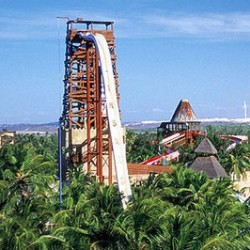 Insano is the highest water slide in the world (41 meters), it is listed in the Guinness Book of Records. Its height is equivalent to the height of a 14-story building. As a result of its height and incline, it provides a very fast descent, 4-5 seconds at a speed of about 105 km / h. Due to such characteristics, the slide is considered the most extreme in the world. At the end of the journey, you will dive into a relaxing pool.
Insano is the highest water slide in the world (41 meters), it is listed in the Guinness Book of Records. Its height is equivalent to the height of a 14-story building. As a result of its height and incline, it provides a very fast descent, 4-5 seconds at a speed of about 105 km / h. Due to such characteristics, the slide is considered the most extreme in the world. At the end of the journey, you will dive into a relaxing pool.
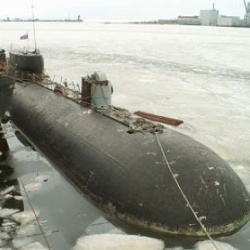 K-222, the former K-162, was the only ever built by the Pope ("Papa" is the western name of the submarine of the Soviet Union, Anchar). Its construction was postponed on December 28, 1963 and again resumed only on December 31, 1969. She served the Soviet Northern Fleet throughout her “career”. It was the fastest submarine in the world; in trials it reached a record speed of 44.7 knots. However, the price of high speed was also high - huge costs during the production process, as well as a strong noise level and significant damage to the case during operation.
K-222, the former K-162, was the only ever built by the Pope ("Papa" is the western name of the submarine of the Soviet Union, Anchar). Its construction was postponed on December 28, 1963 and again resumed only on December 31, 1969. She served the Soviet Northern Fleet throughout her “career”. It was the fastest submarine in the world; in trials it reached a record speed of 44.7 knots. However, the price of high speed was also high - huge costs during the production process, as well as a strong noise level and significant damage to the case during operation.
7. The fastest manned aircraft
 The North American rocket-powered X-15 was part of the X-series experimental aircraft that were manufactured for the US Air Force, NASA, and the US Navy. The speed and altitude of the X-15 were record-breaking for the 1960s, as the aircraft managed to reach the edge of outer space and return with valuable data. He still holds the world record for the fastest speed ever achieved by a manned aircraft. During the X-15 program, 13 of the flights were evaluated by the US Air Force as space because they exceeded a height of 80 km, so the pilots received astronaut status. The highest speed was recorded by the pilot Pete Knight during his flight - 7273 km / h.
The North American rocket-powered X-15 was part of the X-series experimental aircraft that were manufactured for the US Air Force, NASA, and the US Navy. The speed and altitude of the X-15 were record-breaking for the 1960s, as the aircraft managed to reach the edge of outer space and return with valuable data. He still holds the world record for the fastest speed ever achieved by a manned aircraft. During the X-15 program, 13 of the flights were evaluated by the US Air Force as space because they exceeded a height of 80 km, so the pilots received astronaut status. The highest speed was recorded by the pilot Pete Knight during his flight - 7273 km / h.
6. The fastest helicopter
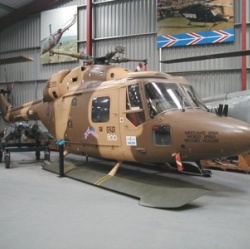 Now we know that the maximum rotor speed of a helicopter can reach, in theory, just over 250 mph. Therefore, at the European air show on August 6, 1986, the Westland Lynx ZB500 helicopter, which reached a speed of 249.1 miles per hour (400.8 km / h), is the fastest helicopter in the world.
Now we know that the maximum rotor speed of a helicopter can reach, in theory, just over 250 mph. Therefore, at the European air show on August 6, 1986, the Westland Lynx ZB500 helicopter, which reached a speed of 249.1 miles per hour (400.8 km / h), is the fastest helicopter in the world.
5. The fastest ... wind
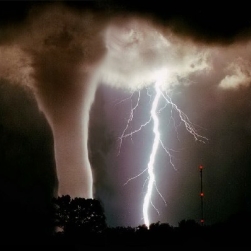 May 3, 1999, when a tornado visited the US state of Oklahoma, scientists recorded the highest rate of wind speed. She was about 318 miles per hour, while a tornado killed 4 people and destroyed 250 houses. Prior to this, the tornado was considered the fastest wind, again visiting Oklahoma, but already in 1991, then its speed was 286 miles per hour. On the Fujita scale (F0-F6), the 1999 tornado did not reach 1 mile to be classified as F6. Not a single tornado in the world has ever received such a level.
May 3, 1999, when a tornado visited the US state of Oklahoma, scientists recorded the highest rate of wind speed. She was about 318 miles per hour, while a tornado killed 4 people and destroyed 250 houses. Prior to this, the tornado was considered the fastest wind, again visiting Oklahoma, but already in 1991, then its speed was 286 miles per hour. On the Fujita scale (F0-F6), the 1999 tornado did not reach 1 mile to be classified as F6. Not a single tornado in the world has ever received such a level.
 Peregrine Falcon is a bird of prey of the falcon family. The size of a gray crow, the falcon has a beautiful blue-gray color of the back, a bright motley belly, a black upper part of the head and a pronounced "black mustache". This bird is considered the fastest in the world, because it can reach speeds in a dive flight of more than 322 km / h.
Peregrine Falcon is a bird of prey of the falcon family. The size of a gray crow, the falcon has a beautiful blue-gray color of the back, a bright motley belly, a black upper part of the head and a pronounced "black mustache". This bird is considered the fastest in the world, because it can reach speeds in a dive flight of more than 322 km / h.
3. The fastest spacecraft
 New Horizons is NASA's automatic spacecraft, which is currently on its way to the planet Pluto. He is expected to be the first spacecraft to explore Pluto and its moons (Charon, Knicks and Hydra). New Horizons was launched on January 19, 2006, its speed was 16.26 km per second. Thus, he left Earth at the highest speed in history. He will approach Pluto on July 14, 2015.
New Horizons is NASA's automatic spacecraft, which is currently on its way to the planet Pluto. He is expected to be the first spacecraft to explore Pluto and its moons (Charon, Knicks and Hydra). New Horizons was launched on January 19, 2006, its speed was 16.26 km per second. Thus, he left Earth at the highest speed in history. He will approach Pluto on July 14, 2015.
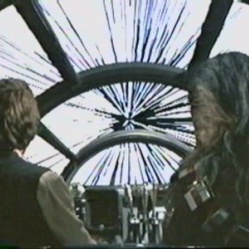 In modern physics, light is the fastest phenomenon in the Universe; its speed in empty space is a fundamental constant. The speed of light in vacuum is 299792245.8 m / s. This is the highest speed of anything that a person has managed to fix. If you could travel around the perimeter of the earth's equator at the speed of light, then you would be able to go around the entire planet in 1 second almost 8 times. Although the scientific community has not yet been able to accurately confirm the existence of something that would move faster than the speed of light, there is an assumption about superluminal particles, which are on our list at number 1.
In modern physics, light is the fastest phenomenon in the Universe; its speed in empty space is a fundamental constant. The speed of light in vacuum is 299792245.8 m / s. This is the highest speed of anything that a person has managed to fix. If you could travel around the perimeter of the earth's equator at the speed of light, then you would be able to go around the entire planet in 1 second almost 8 times. Although the scientific community has not yet been able to accurately confirm the existence of something that would move faster than the speed of light, there is an assumption about superluminal particles, which are on our list at number 1.
1. Superlight particles
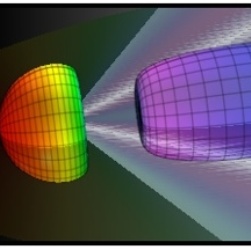 Tachyons are an alleged class of particles that are able to travel faster than the speed of light. The idea of \u200b\u200btachyons was first put forward by the physicist Arnold Sommerfeld. The word tachyon comes from the Greek tachus, which means fast. Tachyons have a strange property: when they lose energy, they begin to gain speed. Therefore, when tachyons receive energy, they slow down. The slowest speed of tachyon movement is claimed to be the speed of light.
Tachyons are an alleged class of particles that are able to travel faster than the speed of light. The idea of \u200b\u200btachyons was first put forward by the physicist Arnold Sommerfeld. The word tachyon comes from the Greek tachus, which means fast. Tachyons have a strange property: when they lose energy, they begin to gain speed. Therefore, when tachyons receive energy, they slow down. The slowest speed of tachyon movement is claimed to be the speed of light.
Modern racing is a risky thing, but it is still largely predictable: tracks are prepared, technical regulations are painted, and treasured experience has been accumulated. On this list are racers of a different kind. Those who literally rushed through life headlong and, burning with a passion for cars, proved over and over again that there are no limits to speed.
1895 - Emil Levassor and the Crazy 30 km / h
The French engineer, industrialist and racer holds the first ever recorded speed record. Achievement is not registered officially, which, however, does not detract from its role in overcoming speed lines.The first cars in the XIX century were not looked at at all as transport. So, with a young lady to "walk", to impress the public ... Actually, they were designed as horse-drawn carts without a horse - the engine was placed under the seats. But in order to develop decent speed, the motor must be cooled. Levassor was the first to think of bringing him forward - to our usual place under the hood.
It was on such a car (double Panhard-Levassor) in June 1895 that the Frenchman won the race along the route Paris-Bordeaux-Paris (1200 km), ahead of the remaining 46 participants. It took him 48 hours 47 minutes to complete the distance, and the average speed was ... 24.4 km / h. Well, yes, not Formula 1. But for the beginning of the era of cars, it was unimaginable. They say Levassor finished the race with the words: “It was crazy! I did up to 50 km / h! ”
1898-99 Dissatisfied electric cars and double record
 Ahead of the surge in interest in environmentally friendly transport by more than a hundred years, to then give way to internal combustion engines, electric vehicles, however, left a noticeable mark in the history of the struggle for speed. A real duel between two such instances and their pilots - Count Gaston de Chaslu-Loba and Camille Zhenatzi - began in 1898 and led to a series of record achievements.
Ahead of the surge in interest in environmentally friendly transport by more than a hundred years, to then give way to internal combustion engines, electric vehicles, however, left a noticeable mark in the history of the struggle for speed. A real duel between two such instances and their pilots - Count Gaston de Chaslu-Loba and Camille Zhenatzi - began in 1898 and led to a series of record achievements. The first, an aristocrat and a descendant of a Napoleonic general, set an official speed record this year - 63.149 km / h. The second, an engineer and son of a rubber tire manufacturer, decided to challenge him. From January to April 1899, both drove like crazy, taking turns surpassing the achievements of the saltwater. Points on i were placed on April 29th. Zhenatzi driving an electric car of his own design (a pseudo-streamlined body of the “aluminum alloy torpedo” type, two direct-drive electric motors with a total capacity of 67 hp) under the name La Jamais Contente (FR. “Forever Dissatisfied”) crossed the 100 km mark for the first time in history / h (fixed speed - 105.876 km / h). His record lasted for more than three years.
1924-2009 Campbell Dynasty Bird of Happiness
Pay attention to the dates in the header. No, the point is not that Sir Malcolm Campbell and his descendants "harnessed for a long time." For over 80 years, restless representatives of this family have been breaking speed records on land and water.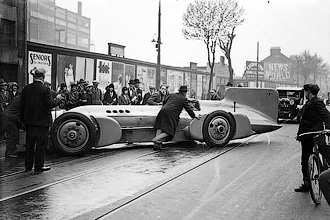 Since 1924, the founder of the dynasty, the English journalist and racer Malcolm Campbell has successively set several world speed records. But his finest hour came in 1935 on the dried salt lake Bonneville, where he brought a car of his own design under the happy name Bluebird (“Blue Bird”) and at the same time overcame significant milestones in two measurement systems - 480 km / h or more than 300 mph .
Since 1924, the founder of the dynasty, the English journalist and racer Malcolm Campbell has successively set several world speed records. But his finest hour came in 1935 on the dried salt lake Bonneville, where he brought a car of his own design under the happy name Bluebird (“Blue Bird”) and at the same time overcame significant milestones in two measurement systems - 480 km / h or more than 300 mph .
His son Donald at first chose the water element, where in 1955 he set two world records at once. But to be the first on water and land at the same time is much cooler. In 1960, Donald designs a new “Blue Bird” - jet thrust. The engine is a gas turbine aircraft "Proteus" with a capacity of 4250 hp, four-wheel drive, 4.3 tons of weight and powerful disc brakes (where without them on such a colossus). And although the first race on the same Bonneville almost ended in disaster, on July 17, 1964, Donald retries on Lake Eyre in Australia. It accelerates to 648 km / h, that is, it swings for 400 mph - and becomes the "double" champion.
Died Donald Campbell at the same outrageous speed at which he lived. On January 4, 1967, while trying to break another water record, his Bluebird K-7 jet boat, turning over at a speed of 482 km / h, crashed into water. Only 34 years later, in 2001, the remains of Donald and his “Birds” were lifted from the bottom. His grave is now on the shore of the same lake.
But the family spirit is quite alive. Donald's son, Don Wales, is no stranger to family passion. In 2009, he set a current speed record for ... a steam engine! 238.68 km / h! What's even more interesting, Don, while you are reading these lines, somewhere will present two electric vehicles developed in the bowels of Bluebird Performance Engineering, a division of the company founded by his grandfather. One of them is a racing car designed specifically for participation in Formula E (there is also such an “electric” series), on it Don is going to accelerate to 500 mph (805 km / h) and set a new record.
1938 Invincible Karach
It’s somehow not customary to talk about the achievements made in Germany during the Third Reich. As if someone's perseverance, ingenuity and sincere sports joy can whitewash this dark period of history. However, in 1938, the German racer Rudolf Karacciola, who later received the nickname “Karach” from the public, set a speed record for a car that has not yet been beaten by anyone. His Mercedes-Benz W125, redesigned from a racing car (an aerodynamic body was added that covered the wheels), accelerated to 432.7 km / h. It was not a matter of the figure itself - three years earlier, Malcolm Campbell drove faster on the Blue Bird. But while the British and Americans tested the "supercars" for strength and power in the middle of the dried up lakes, Karach squeezed everything possible on the public road - the Frankfurt-Darmstadt Autobahn. Nobody did this either before or after.
However, in 1938, the German racer Rudolf Karacciola, who later received the nickname “Karach” from the public, set a speed record for a car that has not yet been beaten by anyone. His Mercedes-Benz W125, redesigned from a racing car (an aerodynamic body was added that covered the wheels), accelerated to 432.7 km / h. It was not a matter of the figure itself - three years earlier, Malcolm Campbell drove faster on the Blue Bird. But while the British and Americans tested the "supercars" for strength and power in the middle of the dried up lakes, Karach squeezed everything possible on the public road - the Frankfurt-Darmstadt Autobahn. Nobody did this either before or after.
1979 or 1997 Stan Barrett and Andy Green: twice in the same river
A curious story came out with overcoming the supersonic barrier on a car. And the whole problem is that the record is not only the perfection of technology and the supply of courage, but also a banal "office". It is not enough to install it, it is also necessary to fix it. This was a problem with the American stuntman Stan Barrett, who in 1979, at the bottom of the salt lake near the Edwards air base in California, accelerated to 1,123 km / h. The speed of its three-wheeled Budweiser Rocket with two jet engines (liquid rocket, powered by a mixture of oxygen and kerosene, plus solid-propellant from an air-to-air missile) recorded on-board equipment and the US Air Force radar. However, the check was made not according to the rules of the FIA. According to them, in order to register the speed, you need to make two runs along the track - there and back - in case the direction of the wind or the slope of the surface could affect the result. Barrett went only one way. In addition, it turned out that the radar was also configured incorrectly. In fact, few doubt that the stuntman really accelerated faster than sound, but formal requirements do not allow him to be considered a champion.
This was a problem with the American stuntman Stan Barrett, who in 1979, at the bottom of the salt lake near the Edwards air base in California, accelerated to 1,123 km / h. The speed of its three-wheeled Budweiser Rocket with two jet engines (liquid rocket, powered by a mixture of oxygen and kerosene, plus solid-propellant from an air-to-air missile) recorded on-board equipment and the US Air Force radar. However, the check was made not according to the rules of the FIA. According to them, in order to register the speed, you need to make two runs along the track - there and back - in case the direction of the wind or the slope of the surface could affect the result. Barrett went only one way. In addition, it turned out that the radar was also configured incorrectly. In fact, few doubt that the stuntman really accelerated faster than sound, but formal requirements do not allow him to be considered a champion.
It is unknown for what reasons that it took another 18 years to do everything as expected. But in the end, on October 15, 1997, the Englishman Andy Green on the 21-kilometer track in the Black Rock desert in Nevada not only officially overcame the supersonic barrier, but also set a current speed record for land vehicles. His car (if this wingless aircraft can also be called a car) accelerated to 1226.522 km / h. In this he was helped by two Rolls-Royce Spey turbojet engines with a total capacity of 110,000 hp. Thrust SSC (Thrust SuperSonic Sag - traction supersonic car) - the so-called record car, reached this speed in just 50 seconds, becoming the fastest car in history. But, as we already understood, for those who are overcome by a thirst for speed, this is not the limit.
History
- The first speed record in a car with an internal combustion engine (up to 30 km / h) belongs to Emil Levassor, put in the Paris-Bordeaux-Paris race in 1895.
- The first officially recorded absolute speed record - 63.149 km / h - installed on December 18, 1898, Count Gaston de Chaslu-Loba on an electric car designed by Charles Gento at a distance of 1 km.
- 100 km line the first to step over on April 29, 1899 was the Belgian Camille Zhenatzi, who was on the electric car “La Jamais Contente” (with fr.- "Always dissatisfied") with an engine power of 67 liters. from. It developed a speed of 105.876 km / h.
- 200 km line speed was achieved in 1911 by racer R. Boorman. On a Benz car, he showed 228.04 km / h.
- 300 km line was first achieved by H. O. D. Sigrev in 1927. On the Sunbim car, he showed 327.89 km / h.
- 400 km line Malcolm Campbell first “crossed the speed” in the Nepir-Campbell car in 1932 (408.63 km / h).
- 500 km milestone speed was overcome in 1937 by John Ayston on a Rolls-Royce-Ayston car (502.43 km / h).
- 1000 km line For the first time, October 23, 1970, the American Harry Gabelich overcame speed on a rocket car “Blue Flame” (“Blue Flame”) on the dried salt lake Bonneville, showing an average speed of 1014.3 km / h. The Blue Flame had a length of 11.3 m and a weight of 2250 kg.
- For the first time, the speed of sound in a car He overcame 36-year-old professional American stuntman Stan Barrett on a three-wheeled Budweiser Rocket jet engine. 2 engines were installed on the car. The main engine is a liquid propellant rocket engine with a thrust of 9900 kgf. The second engine, a solid propellant solid propellant engine with a thrust of 2000 kgf, was installed in case the thrust of the main engine would not be enough to overcome the speed of sound. Check-in took place at the air base « Edwards » (California, USA) in December 1979. But this record was not officially registered by the FIA, since according to the rules of this organization, to register a record, it is necessary to make two arrivals in opposite directions to exclude the influence of wind and the slope of the track. The record speed is the arithmetic average of the speed in these two races. However, Stan Barrett refused the second race, believing that the record was set. However, since the radar used to measure the speed turned out to be out of sync and aimed at the car manually, many historians of record car rides are doubting the achievement of a supersonic record speed in that race, in particular, it is not in the official report of the US armed forces written by officers driving the radar during check-in.
- The milestone of 1,000 mph (1,609 km / h) plans to overcome one car.
Bloodhound SSC designers have plans to set a new record. The car will be equipped with three engines: a hybrid rocket engine, a Eurojet EJ200 jet engine used on an Eurofighter Typhoon fighter aircraft, and a Jaguar 8-cylinder V-shaped gasoline engine used to drive pumps that pump fuel to the rocket engine and drive the onboard electric generator.
It is believed that the first speed record belongs to the French racer and designer Emile Levassor, who set it during the Paris-Bordeaux race. The whole world remembers his phrase, which served as the beginning of the desire for high speeds: “We gave out thirty kilometers per hour! It was a real madness! ” But in 1895 there were no official rules for determining record levels, so formally the French engineer was left without the status of a pioneer.
And he went to Count Gaston de Chaslau-Loba, who took care of registering his achievement. The car, developed by designer Charles Gento, at a distance of 1 kilometer accelerated to 63 km / h. The title of record holder was decided to take for himself his eternal rival - professional race car driver Camille Zhenatzi, accelerating in just a few days to 66 km / h. That is how the long-standing confrontation began, during which the machines continued to improve and receive more and more improved power units, as well as aerodynamic bodies. In 1899, the Count de Chaslau-Loba finally managed to significantly outrun the enemy, reaching 92.7 km / h - then such a speed was considered simply unattainable.
But only two months later Camille Zhenatzi set the first significant speed record for a car - he overcame the milestone of 100 km / h, exceeding it by 5 kilometers. He owed much of his incredible success to a new vehicle - a car with the name "Forever Dissatisfied", which was equipped with electric motors and had a streamlined body made of alloyed aluminum alloy.
Surprisingly, the first milestone for the first time was overcome by steam transport, which has not yet been completely deducted from the account - in 1906, racer Fred Marriott in a Stanley car accelerated to 205 km / h. Internal combustion engines, then still very imperfect, could not reach such a record. But in 1909, a Blitzen Benz car driven by Victor Emery on the Brookland track in the UK showed a result of 202 km / h. Two years later, Robert Boorman set the next world speed record by using a car with ICE - he reached a value of 228 km / h.
The next world speed record was set by Henry Sigrev, who used the Sunbeam "The Slug" 1000 hp car, equipped with two aircraft engines with a total capacity of 900 horsepower. On the Daytona Beach highway in 1927, it accelerated to 327 km / h, which allowed it to simultaneously exceed the milestone of miles - 200 per hour. Interestingly, unlike the pre-existing prototypes, this car was not at all light - its total starting weight exceeded 4 tons!
Another famous driver, Malcolm Campbell, who had tried several times before unsuccessfully to set the world speed record in a Blue Bird car equipped with a Napier motor, could not put up with Sigrev's championship. In 1931, Campbell brought to Daytona Beach a new generation of his famous car, which had the name Campbell-Napier-Railton. During two races, he showed a speed of 396 km / h, only a little short of the next threshold. However, a year later, he returned with a slightly modified machine, and reached a speed of 404 km / h, having officially entered his name in history and received the title of knight.
Soon, however, internal combustion engines had to make room, giving way to more powerful jet turbines. But until this happened, the American John Aston took advantage of the maximum available engine power at that time by installing two Rolls-Royce aircraft engines with a capacity of 5,000 horsepower on his car. In 1937, his record car reached a speed of 502 km / h, driving several times along the bottom of the dry Lake Bonneville. In 1939, this record was raised to 575 km / h, but Eiston refused further competition, and soon he was ahead of the driver John Cobb, who showed the result first at 595, and then at 640 km / h.
After World War II, most riders switched to jet engines, which seemed to them more promising. Indeed, on the same parched Lake Bonneville, the American Harry Gabelich in 1970 accelerated to a speed of 1014 km / h. Such a car, called the Blue Flame, was equipped with one jet turbine, the thrust of which reached approximately 22 thousand horsepower. In 1979, it was announced that stuntman Stanley Barrett overcame the speed of sound, but the rider did not want to make the second race according to the rules for setting records, and the army experts involved in the measurements did not record its achievement.
To date, the maximum speed record for the car belongs to the supersonic vehicle Thrust SSC, which showed a result of 1228 km / h. Corresponding confirmation was made in 1997, when the car entered the track in the Black Rock desert of the United States. The car was equipped with two Rolls-Royce Spey turbofan engines operating in afterburner mode - their total power reached 110 thousand horsepower. Especially for driving such an incredible vehicle, the Royal Air Force pilot Andy Green, who holds the title of the fastest driver, was invited.


